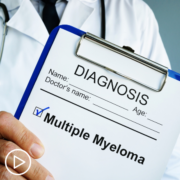How Do Myeloma Test Results Guide Prognosis and Treatment?
How Do Myeloma Test Results Guide Prognosis and Treatment? from Patient Empowerment Network on Vimeo.
Myeloma specialist Dr. Peter Forsberg explains how myeloma test results help in assessing the disease stage and prognosis, and how identification of chromosomal abnormalities may aid in treatment decisions.
Dr. Peter Forsberg is assistant professor of medicine at the University of Colorado School of Medicine and is a specialist in multiple myeloma. More about Dr. Forsberg here.
Download Program Resource Guide
See More From The Pro-Active Myeloma Patient Toolkit
Related Resources:
Transcript:
Katherine:
What do the results of these tests tell us about prognosis and treatment choices?
Dr. Forsberg:
So, the tests that we do are important in terms of understanding some degree how aggressive the myeloma may be or what the prognosis may be. One of the most common or challenging things to break through when diagnosing myeloma or learning about your myeloma is that it’s a little different than other types of cancer. Unlike other cancers that’re more common, stage in myeloma is very different than it is in breast cancer or lung cancer or things that people may have more experience with. In myeloma, everybody has systemic disease.
That’s a part of the diagnosis of myeloma. It means it’s a body-wide condition. So, being stage I or II or III is very different than what it might be in other diseases where that has a huge prognostic impact and also, really shapes what treatment might be. In myeloma, we do use blood tests and chromosomal changes to help us assign a stage to the myeloma, which may tell us about how aggressive the myeloma may be over time.
But our treatment approaches tend to be pretty similar, even for people regardless of their stage. So, our goals are always to get patients’ myeloma under control and maintain it there. So, treatment ends up overlapping pretty substantially. Regardless of what those in initial tests are that stratify potential disease aggressiveness. That being said, there are some ways that we do adjust treatment potentially in patients that we see evidence of potentially more aggressive disease or less. And that might be ways that we amplify treatment regiments, adding extra medicines or using maintenance approaches that’re a little more robust to try to help overcome those high-risk features.
Katherine:
What about the significance of chromosomal abnormalities?
Dr. Forsberg:
So, chromosomal abnormalities are part of some of those staging systems. They’re included in what we call our revised international staging system, as well as just being part of our routine risk assessment.
To try to understand myeloma. So, in myeloma, at this point those genetic changes or chromosomal changes don’t necessarily drive specific treatment choices except in that they may stratify how aggressive disease could be and may be informative in that regard.













